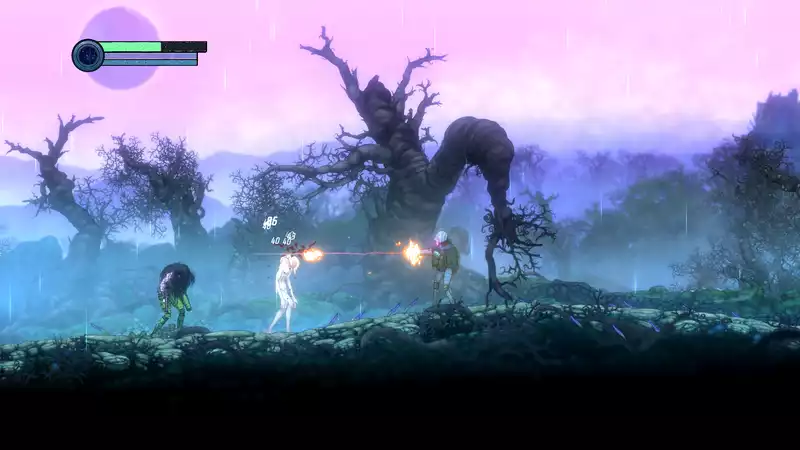Repetition is the bread and butter of fun Metroidvania, but as you wander through Ghost Song's endless maze of similar underground corridors in search of the next story beat, you can't help but wonder where you went wrong. The first impression is deceivingly strong, thanks in part to the attractive hand-drawn art style, but the frustrating limitations of the mechanics come to the fore as you begin to understand the clunky combat and confusing level design. [You play as Deadsuit, a robot awakened from an ancient slumber on the desolate planet Lorien. Your true name and origins are shrouded in mystery, so your first task is to explore this unfamiliar environment and search for answers. The eerie and oppressive atmosphere that forms the planet's surface is immediately captivating. Everything is enveloped in an ominous, supernatural light, and the beautiful background art is littered with the wreckage of countless crashed spacecraft, evoking an imminent sense of isolation and decay. Once underground, this art direction remains a consistent highlight, and Metroid's roots are clearly visible in the attractive design of the dead suit with its faceless visor and familiar arm-mounted plasma cannon.
As you begin to encounter the legions of Lorien's mutated inhabitants, the first of many gross negligence becomes painfully apparent. The awkward keyboard control scheme makes Deadsuit a far more unwieldy hero than any of Nintendo's protagonists, and while the unwieldy bindings can be adjusted from the options menu, the lack of mouse support means that while playing with the keyboard, aiming is severely hampered. It is simply impossible to aim at certain angles using the arrow keys, which can be quickly remedied with a compatible controller, but this limitation makes some of the later sections, dominated by fast-flying enemies, nearly impossible to clear.
Even with a controller in hand, the slow maximum walking speed and inexplicably floaty jumps make movement feel slow. As one would expect from a game of this genre, further movement options, such as the requisite double jump and sprinting ability, are gradually unlocked as you progress, but it is difficult to ignore the frankly unpleasant degree of inaccuracy that pervades most platform attempts throughout the journey. Combat suffers from similar sloppiness, with strange hitboxes causing enemies to die through hard surfaces at least a dozen times.
And then there are the truly diabolical dodges, which are incredibly difficult to judge visually. A meter that displays invincibility time every few dodges provides an intuitive alternative to the opaque invincibility frames that are common in other Souls-like games.
These problems are most pronounced in boss fights, where repetitive encounter trials filled with oversized hitboxes and inconsistent attack patterns push the combat system to its absolute limits. Poorly placed save points force the player to waste time and return to the fight after an unjustified death.
However, there is still a glimmer of hope in Ghost Song's foundation, and one mechanic, which buffs melee damage but overheats after prolonged use of projectile weapons, leads to a comfortable rhythm of whittling down the strength of weaker enemies before slapping a satisfying killing punch This leads to a comfortable rhythm of whittling down weaker foes' health before delivering a satisfying killing punch. The upgrade system is equally enjoyable, with a variety of modules that enhance suits and blasters. Each has its own personality and practicality, such as a barrage of friendly slimes aimed at the enemy or the ability to see the enemy's health bar. Also, for every enemy you defeat, you get a nanocell, which is a statuette (a giant fallen robot) located near the save point, a currency that can be used for additional stat upgrades.
On standard difficulty, death not only causes you to lose your current collection of nanocells, but also reduces your overall health pool. This can only be recovered by consuming more nanocells at the statue, creating a kind of Catch-22. The only time the dead suit needs to be repaired is immediately after it dies and loses all of its cells, when the newly reduced health bar makes it much more difficult to reach the statue. The amount needed to repair is thankfully very small, but the very small number of statues often means that a considerable detour is required to reach the statues. It is a waste of time and does little to help.
This frustration is further exacerbated by the basic map design. You spend the entire game in a single dungeon, and even after unlocking several late-game exploration options, the exploration choices remain disappointingly linear. The number of interconnected zones is kept to a minimum, so there are few substantial shortcuts throughout, and most of the roughly 10 hours required to complete the story are spent turning back over familiar ground. There are a tiresome number of dimly lit corridors that are almost identical to this subterranean area.
At a time when new Metroidvanias are popping up all the time and classics like "Dead Cells" keep coming out with charming updates, "Ghost Song" has little to offer. Dead Suit should stay dead.
.

Comments